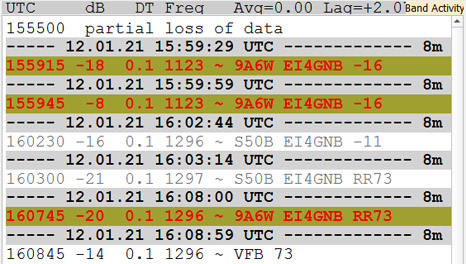
It's a well known fact that most countries do most of their trade with their nearest neighbours and that was certainly the case with Ireland as it imports a huge amount of goods from the UK. For those in Ireland interested in buying radio equipment or electronics gear, the retailers in the UK have traditionally been the largest source by far.
On the 1st of January 2021, all of that changed as the UK became a third country outside of the European Union. The bad news is that any goods imported from the UK into Ireland & the EU are likely to be more expensive and may be subject to customs duties, taxes and import fees.
The good news is that there are plenty of alternatives in the European Union where all of the expense and hassle can be avoided.
(Update 10th Jan 2021: As Brexit has become a reality, it's clear that it may be best to avoid buying from the UK to avoid all the hassle and expense. Updated links for EU sources below)
Links...
Amazon Germany (English Version)... https://www.amazon.de/?language=en_GB
RS Components (Europe)... https://www.rs-components.com/index.html
Amateur Radio Equipment
EU Countries with the EURO
Ireland
Long Communications (Ireland)... https://longcom.ie/
Wescom Ireland (Ireland)... https://wescom.ie/
France
Poly-Com (France - Dept 06)... https://www.poly-com.com/fr/
Radio-Sav (France - Dept 33)... https://radio-sav.fr/
SAV-Radio 33 (France - Dept 33)... http://www.sav-radio33.eu/
SUD Communication (France - Dept 34)... http://www.sudcom.info/
CB+ (France - Dept 59)... https://www.cbplus.com/
Connectyland.Fr (France - Dept 60)... https://www.connectyland.fr/gb/
RF-Market (France - Dept 63)... https://rf-market.fr/
Zenith Antennes (France - Dept 66)... https://www.zenithantennes.fr/
Batima Electronic (France - Dept 67)... https://batima-electronic.com/
Stereance (France - Dept 69)... https://www.stereance.com/
Passion Radio (France - Dept 75)... https://www.passion-radio.com/
Radio Media System (France - Dept 76)... https://radio-media-system.com/
GoTechnique (France - Dept 92)... https://www.gotechnique.com/
Germany
WiMo (Germany)... https://www.wimo.com/en/radios
Funktechnik Bielefeld (Germany)... https://www.funktechnik-bielefeld.de/
Funktechnik Dathe (Germany)... https://funktechnik-dathe.de/
Funktechnik Dresden (Germany)... http://www.funktechnik-dresden.de/
Funktechnik Seipelt (Germany)... http://www.funktechnik-seipelt.de/
Difona Communication (Germany)... https://difona.de/en
QRP-Shop (Germany)... https://www.qrp-shop.biz/en_GB
Wellenjagd (Germany)... https://www.wellenjagd.com/
Bonito (Germany)... https://www.bonito.net/hamradio/en/
Funk24 (Germany)... https://shop.funk24.net/
Funkshop (Germany)... https://www.funkshop.com/amateurfunk.html
Sarikaya-Funk (Germany)... http://www.sarikaya-funk.de/
Tino's Funk (Radio) Shop (Germany)... https://www.tinos-funkshop.de/
FGH Electronics (Germany)... https://www.fgh-funkgeraete.de/
Haro-Electronic (Germany)... https://haro-electronic.de/
Dieter Knauer Funkelektronik (Germany)... https://www.knauer-funk.de/
Winkler Spezial Antenne (Germany)... https://www.winklerantennenbau.de/
Netherlands
Hamshop (Netherlands)... https://www.hamshop.nl/
Dolstra (Netherlands)... https://www.dolstra.nl/
Classic International (Netherlands)... https://www.classicinternational.eu/
Communication World (Netherlands)... https://www.communicationworld.nl/
Venhorst (Netherlands)... https://www.venhorst.nl/index.php?route=common/home
GB Antennes (Netherlands)... https://www.gbantennes.com/en/
Truckerswereld (Netherlands)... www.Truckerswereld.nl
BCI Communications (Netherlands)... https://www.bcihaarlem.nl/
Stockcorner (Netherlands)... http://www.stockcorner.nl/index.php/en/
HF Kits (Netherlands)... https://www.hfkits.com/
Dutch RF Shop (Netherlands)... https://dutchrfshop.nl/en/
K-PO (Netherlands)... https://www.k-po.com/index.php
Flex-Radio (Netherlands)... https://www.flex-radio.nl/
SDRPlay (Netherlands)... https://sdrplay.nl/
Flexcoax (Netherlands)... https://flexcoax.com/
Jacobs Breda Electronics (Netherlands)... https://www.jbe.nl/
Ham Radio Tools (Netherlands)... https://www.hamradiotools.eu/
Rys Electronics (Netherlands)... https://www.rys.nl/
Handelsonderneming Veenstra (Netherlands)... https://www.handelsondernemingveenstra.nl/en/
Belgium
XBS Telecom (Belgium)... https://www.xbstelecom.eu/shop/en/
Fil's Radio Store (Belgium)... https://filsradio.store/
HF Electronics (Belgium)... https://www.hfelectronics.be/
Luxembourg
Orbito (Luxembourg)... http://www.orbito.com/
Portugal
DX Patrol (Portugal)... https://www.dxpatrol.pt/
Germano Lopes & CIA, LDA (Portugal)... https://germanolopes.com/
Spain
QRP Ham Radio Kits (Spain)... https://www.qrphamradiokits.com/
Astro Radio (Spain)... https://www.astroradio.com/
Radiotrans (Spain)... https://www.radiotrans.com/index.php/en/productos/radio/59/62
AGV Radio (Spain)... http://agvradio.com/
EAXBeam (Spain)... http://eaxbeam.com/shop/index.php
GCN Radioaficion (Spain)... http://www.gcnradioaficion.com/
HamBuy.es (Spain)... https://www.hambuy.es/
Italy
Ham Radio Shop (Italy)... https://www.hamradioshop.it/
FlexRadio (Italy)... https://flexradio.it/
Hard Soft Products HSP (Italy)... https://www.hspshop.it/
CSY & Son (Italy)... https://www.csyeson.it/en/
Media Globe Electronics (Italy)... https://www.mediaglobe.it/
Radio Frequenza Shop (Italy)... https://www.radiofrequenzashop.com/
MHzOutdoor (Italy)... https://www.mhzoutdoor.com/
Austria
Funkelectronik (Austria)... https://www.funkelektronik.at/de/
Greece
SILCOM (Greece)... https://silcom-ant.gr/e-shop/
SV1AFN (Greece)... https://www.sv1afn.com/
FreeBytes Communications-Computers (Greece)... https://www.freebytes.com/catalog/index.php
Finland
Dig1 Verkkokauppa (Finland) ... https://dig1-verkkokauppa.vilkas.shop/
Koneita (Finland)... https://koneita.com/fi/7235-radiolaitteet
Malta
Jason Kits (Malta) ... https://www.tindie.com/stores/jasonkits/
EU Countries not using the EURO
Hungary
DND Telecom Center (Hungary)... https://www.dnd.hu/home
Anico (Hungary)... https://www.anico.hu/
Poland
Konektor (Poland)... https://www.konektor5000.pl/
ErComEr (Poland)... https://www.ercomer.pl/
InRadio (Poland)... https://www.inradio.pl/
Avanti Radiokomunikacja (Poland)... https://www.avantiradio.pl/
Radio-Sklep Radom (Poland)... https://www.radio-sklep.pl/
Ten-Tech (Poland)... https://ten-tech.pl/
Tel-Tad (Poland)... https://www.teltad.pl/
Czech Republic
RemoteQTH (Czech Republic)... https://remoteqth.com/
HCS Komunikacni Systemy (Czech Rep)... http://www.hcsradio.cz/
RScom (Czech Rep)... https://shop.rscom.cz/12-cb-radiostanice
hamshop.cz (Czech Rep)... https://www.hamshop.cz/
Slovak Republic
Anico (Slovakia)... http://www.anico.sk/
Sweden
Limmared Radio & Data (Sweden)... https://butik.limmared.nu/en/
Antennera (Sweden)... https://www.antennerna.se/
DXSupply (Sweden)... https://dxsupply.com/
TactiCom (Sweden)... https://tacticom.se/
LOH Electronics (Sweden)... https://www.lohelectronics.se/kommunikation/amatorradio
Denmark
Midtkom (Denmark)... https://www.midtkom.dk/shop/frontpage.html
Bulgaria
Integra-A (Bulgaria)... https://integra-a.com/
Romania
Anico Romania (Romania)... https://anicoromania.ro/
Electronics Equipment
EU Countries with the EURO
Conrad (Germany)... https://www.conrad.com/
AZ-Delivery (Germany)... https://www.az-delivery.de/en
Reichelt Electronik (Germany)... https://www.reichelt.de/
Kiwi Electronics (Netherlands)... https://www.kiwi-electronics.nl/index.php?route=common/home
BACO Army Goods (Netherlands)... https://www.baco-army-goods.nl/
Electrodump Surplus Electronics (Netherlands)... http://www.elektrodump.nl/en/
Van Dijken Electronica (Netherlands)... https://www.vandijkenelektronica.eu/en/
RF Hamdesign (Netherlands)... https://www.rfhamdesign.com/
HAJÉ Electronics (Netherlands)... https://www.haje.nl/
ON7FU Ferrite Applications (Belgium)... http://www.on7fuferriteapplications.com/
Hard Soft Products HSP (Italy)... https://www.hspshop.it/
EU Countries not using the EURO
TME Electronic Components (Poland)... https://www.tme.eu/
Loh Electronics (Sweden)... https://www.lohelectronics.se/
If anyone else knows of any other reputable retailers in the European Union then let me know and I'll add them.
Updated: 27th April 2024



































